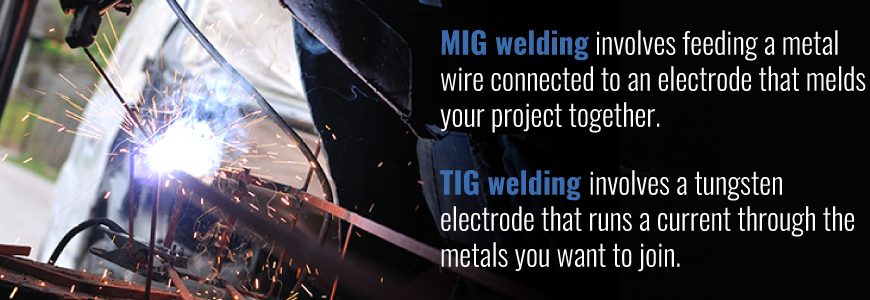Using TIG welder and MIG welder for welding could be the difference in your project that takes it to the next level. You could greatly reduce the time and effort spent making it and improve the quality and durability of the final product.
Knowing the kinds of projects that TIG and MIG welds are suited for can lead you to a decision about which weld type you should use for your own endeavor.
TIG WELDING APPLICATIONS
If your project has certain needs or characteristics, your best choice may be TIG welding. Here are some of the best instances and applications for choosing it for your next welding project:
- You’re welding thinner metals: If your project uses thinner metals or is smaller, then TIG is the way to go. It’s better for precise welds that leave your project looking great and requires little to no cleaning.
- You have good hand-eye coordination and have practiced: TIG welding is a three-part process where you need to have strong hand-eye and hand-foot coordination. It’s a delicate technique that needs practice and patience. The foot control allows for more precision when controlling the heat.
- You’re working with easier-to-reach angles: While welders like using the foot pedal for TIG welding, that method might not work when you’re trying to weld smaller areas at odd angles. For these, consider using finger-tip control so you can get to those angles and weld them correctly.
- You’re welding the appropriate metals: TIG can work with many kinds of metal, like aluminum and copper, but not with cast iron.
- You’re welding shorter runs: Short-run, technical welds are best for TIG welding. Longer runs can be more difficult and expensive.
- You’re taking on a delicate or artistic project: If your project is something like a toolbox or a sink, TIG is a better option. TIG also works best with artwork, such as ornamental designs and automotive projects. When your project’s final appearance matters, you may want to choose TIG welding.
MIG WELDING APPLICATIONS
Your project may need the unique abilities of MIG welding for success. Consider choosing MIG welding if your project includes the following scenarios and demands:
- You’re welding thicker or bigger pieces of metal: If your project uses thicker and bigger pieces of metal that are going to need a lot of welding work, MIG is the option for you. The filler material that’s fed continuously on a spool will connect your pieces together to get the final product you want. This form of welding might require some grinding or smoothing after the welding process.
- You want a smoother process with fewer defects: The continuous nature of MIG reduces the chance of a defect because you don’t have to worry about starting and stopping repeatedly.
- You’re working at difficult angles or need a free hand for more control: MIG welds have triggers that control the operation and allow a free hand for tacking or holding the materials in a certain way so they can weld correctly.
- You need to weld longer runs: MIG welds can handle longer production runs because they’re easier to manage and work faster than TIG welds.
- You’re new to welding: MIG welding is better suited for bigger projects because it’s easier to handle and can do longer welds.
Why Choose Perfwctpower for Your Welding Needs?
At PerfectPower Welding Machine & Manufacturing, we are a full-service job shop and repair company specializing in manufacturing large assemblies and subassemblies in prototype to full production quantities. In addition to our machining and grinding capabilities, our secondary services range from fabrication and welding to complete repair, replacement, and reassembly.
Our fully certified welders are well-versed in MIG and TIG welding and accommodate aluminum, carbon steel, and stainless steel materials. Some of the typical products we assemble and repair.
To learn more about our welding capabilities, contact us or request a quote today.

